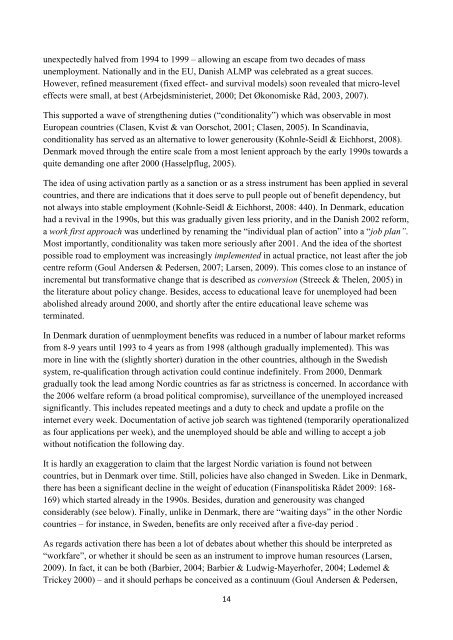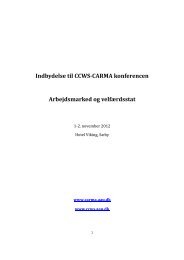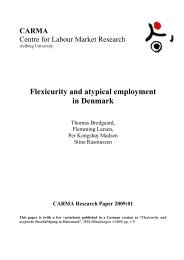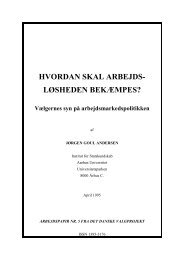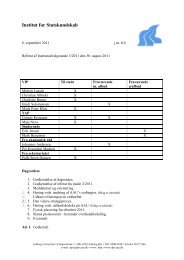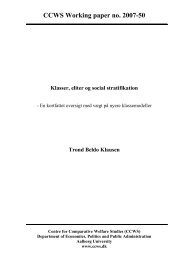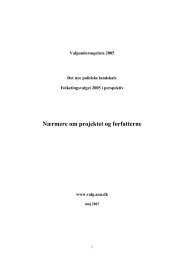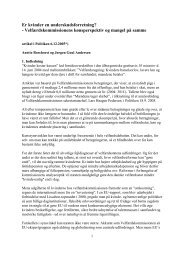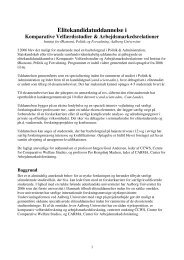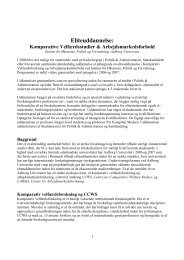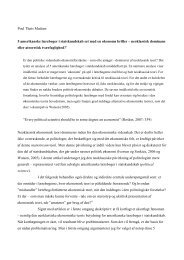Ageing and welfare reform in the Nordic Countries, 1990-2010 ...
Ageing and welfare reform in the Nordic Countries, 1990-2010 ...
Ageing and welfare reform in the Nordic Countries, 1990-2010 ...
You also want an ePaper? Increase the reach of your titles
YUMPU automatically turns print PDFs into web optimized ePapers that Google loves.
unexpectedly halved from 1994 to 1999 – allow<strong>in</strong>g an escape from two decades of massunemployment. Nationally <strong>and</strong> <strong>in</strong> <strong>the</strong> EU, Danish ALMP was celebrated as a great succes.However, ref<strong>in</strong>ed measurement (fixed effect- <strong>and</strong> survival models) soon revealed that micro-leveleffects were small, at best (Arbejdsm<strong>in</strong>isteriet, 2000; Det Økonomiske Råd, 2003, 2007).This supported a wave of streng<strong>the</strong>n<strong>in</strong>g duties (“conditionality”) which was observable <strong>in</strong> mostEuropean countries (Clasen, Kvist & van Oorschot, 2001; Clasen, 2005). In Sc<strong>and</strong><strong>in</strong>avia,conditionality has served as an alternative to lower generousity (Kohnle-Seidl & Eichhorst, 2008).Denmark moved through <strong>the</strong> entire scale from a most lenient approach by <strong>the</strong> early <strong>1990</strong>s towards aquite dem<strong>and</strong><strong>in</strong>g one after 2000 (Hasselpflug, 2005).The idea of us<strong>in</strong>g activation partly as a sanction or as a stress <strong>in</strong>strument has been applied <strong>in</strong> severalcountries, <strong>and</strong> <strong>the</strong>re are <strong>in</strong>dications that it does serve to pull people out of benefit dependency, butnot always <strong>in</strong>to stable employment (Kohnle-Seidl & Eichhorst, 2008: 440). In Denmark, educationhad a revival <strong>in</strong> <strong>the</strong> <strong>1990</strong>s, but this was gradually given less priority, <strong>and</strong> <strong>in</strong> <strong>the</strong> Danish 2002 <strong>reform</strong>,a work first approach was underl<strong>in</strong>ed by renam<strong>in</strong>g <strong>the</strong> “<strong>in</strong>dividual plan of action” <strong>in</strong>to a “job plan”.Most importantly, conditionality was taken more seriously after 2001. And <strong>the</strong> idea of <strong>the</strong> shortestpossible road to employment was <strong>in</strong>creas<strong>in</strong>gly implemented <strong>in</strong> actual practice, not least after <strong>the</strong> jobcentre <strong>reform</strong> (Goul Andersen & Pedersen, 2007; Larsen, 2009). This comes close to an <strong>in</strong>stance of<strong>in</strong>cremental but transformative change that is described as conversion (Streeck & Thelen, 2005) <strong>in</strong><strong>the</strong> literature about policy change. Besides, access to educational leave for unemployed had beenabolished already around 2000, <strong>and</strong> shortly after <strong>the</strong> entire educational leave scheme wasterm<strong>in</strong>ated.In Denmark duration of uenmployment benefits was reduced <strong>in</strong> a number of labour market <strong>reform</strong>sfrom 8-9 years until 1993 to 4 years as from 1998 (although gradually implemented). This wasmore <strong>in</strong> l<strong>in</strong>e with <strong>the</strong> (slightly shorter) duration <strong>in</strong> <strong>the</strong> o<strong>the</strong>r countries, although <strong>in</strong> <strong>the</strong> Swedishsystem, re-qualification through activation could cont<strong>in</strong>ue <strong>in</strong>def<strong>in</strong>itely. From 2000, Denmarkgradually took <strong>the</strong> lead among <strong>Nordic</strong> countries as far as strictness is concerned. In accordance with<strong>the</strong> 2006 <strong>welfare</strong> <strong>reform</strong> (a broad political compromise), surveillance of <strong>the</strong> unemployed <strong>in</strong>creasedsignificantly. This <strong>in</strong>cludes repeated meet<strong>in</strong>gs <strong>and</strong> a duty to check <strong>and</strong> update a profile on <strong>the</strong><strong>in</strong>ternet every week. Documentation of active job search was tightened (temporarily operationalizedas four applications per week), <strong>and</strong> <strong>the</strong> unemployed should be able <strong>and</strong> will<strong>in</strong>g to accept a jobwithout notification <strong>the</strong> follow<strong>in</strong>g day.It is hardly an exaggeration to claim that <strong>the</strong> largest <strong>Nordic</strong> variation is found not betweencountries, but <strong>in</strong> Denmark over time. Still, policies have also changed <strong>in</strong> Sweden. Like <strong>in</strong> Denmark,<strong>the</strong>re has been a significant decl<strong>in</strong>e <strong>in</strong> <strong>the</strong> weight of education (F<strong>in</strong>anspolitiska Rådet 2009: 168-169) which started already <strong>in</strong> <strong>the</strong> <strong>1990</strong>s. Besides, duration <strong>and</strong> generousity was changedconsiderably (see below). F<strong>in</strong>ally, unlike <strong>in</strong> Denmark, <strong>the</strong>re are “wait<strong>in</strong>g days” <strong>in</strong> <strong>the</strong> o<strong>the</strong>r <strong>Nordic</strong>countries – for <strong>in</strong>stance, <strong>in</strong> Sweden, benefits are only received after a five-day period .As regards activation <strong>the</strong>re has been a lot of debates about whe<strong>the</strong>r this should be <strong>in</strong>terpreted as“workfare”, or whe<strong>the</strong>r it should be seen as an <strong>in</strong>strument to improve human resources (Larsen,2009). In fact, it can be both (Barbier, 2004; Barbier & Ludwig-Mayerhofer, 2004; Lødemel &Trickey 2000) – <strong>and</strong> it should perhaps be conceived as a cont<strong>in</strong>uum (Goul Andersen & Pedersen,14


